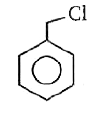Which one is most reactive towards SN1 reactions ?
C6H5CH(C6H5)Br
C6H5CH(CH3)Br
C6H5C(CH3)(C6H5)Br
C6H5CH2Br
The correct Answer is:C
To determine which compound is most reactive towards SN1 reactions, we need to analyze the stability of the carbocations formed during these reactions. The more stable the carbocation, the more reactive the compound will be in an SN1 reaction.
1. Understand SN1 Mechanism:
- SN1 (Substitution Nucleophilic Unimolecular) reactions involve the formation of a carbocation intermediate. The stability of this carbocation is crucial for the reactivity of the compound.
2. Analyze Each Option:
- Option 1: C₆H₅CH(C₆H₅)Br
- Upon losing Br, it forms a benzyl carbocation stabilized by resonance from two phenyl rings.
- Stability: High due to resonance stabilization from two phenyl groups.
- Option 2: C₆H₅CH(CH₃)Br
- Upon losing Br, it forms a carbocation that is stabilized by one phenyl ring and the inductive effect of the methyl group.
- Stability: Moderate due to one phenyl group and inductive effect.
- Option 3: C₆H₅C(CH₃)C₆H₅Br
- Upon losing Br, it forms a carbocation that is stabilized by two phenyl rings and the inductive effect of the methyl group.
- Stability: Very high due to resonance from two phenyl groups and inductive effect from the methyl group.
- Option 4: C₆H₅CH₂Br
- Upon losing Br, it forms a primary carbocation that is only stabilized by one phenyl ring.
- Stability: Low due to only one phenyl group providing resonance stabilization.
3. Compare Carbocation Stability:
- Option 1: Stabilized by 2 phenyl rings (highest stability).
- Option 2: Stabilized by 1 phenyl ring and a methyl group (moderate stability).
- Option 3: Stabilized by 2 phenyl rings and a methyl group (very high stability).
- Option 4: Stabilized by 1 phenyl ring (lowest stability).
4. Conclusion:
- The most stable carbocation is formed from Option 3 (C₆H₅C(CH₃)C₆H₅Br), making it the most reactive towards SN1 reactions.
Final Answer:
Option 3 (C₆H₅C(CH₃)C₆H₅Br) is the most reactive towards SN1 reactions.
- SN1 (Substitution Nucleophilic Unimolecular) reactions involve the formation of a carbocation intermediate. The stability of this carbocation is crucial for the reactivity of the compound.
- Option 1: C₆H₅CH(C₆H₅)Br
- Upon losing Br, it forms a benzyl carbocation stabilized by resonance from two phenyl rings.
- Stability: High due to resonance stabilization from two phenyl groups.
- Upon losing Br, it forms a carbocation that is stabilized by one phenyl ring and the inductive effect of the methyl group.
- Stability: Moderate due to one phenyl group and inductive effect.
- Upon losing Br, it forms a carbocation that is stabilized by two phenyl rings and the inductive effect of the methyl group.
- Stability: Very high due to resonance from two phenyl groups and inductive effect from the methyl group.
- Upon losing Br, it forms a primary carbocation that is only stabilized by one phenyl ring.
- Stability: Low due to only one phenyl group providing resonance stabilization.
- Option 1: Stabilized by 2 phenyl rings (highest stability).
- Option 2: Stabilized by 1 phenyl ring and a methyl group (moderate stability).
- Option 3: Stabilized by 2 phenyl rings and a methyl group (very high stability).
- Option 4: Stabilized by 1 phenyl ring (lowest stability).
- The most stable carbocation is formed from Option 3 (C₆H₅C(CH₃)C₆H₅Br), making it the most reactive towards SN1 reactions.
Option 3 (C₆H₅C(CH₃)C₆H₅Br) is the most reactive towards SN1 reactions.
Topper's Solved these Questions
- HALOALKANES AND HALOARENES BOOK - AAKASH INSTITUTE ENGLISHCHAPTER - HALOALKANES AND HALOARENES EXERCISE - ASSIGNMENT SECTION -D
15 Videos
- HALOALKANES AND HALOARENES BOOK - AAKASH INSTITUTE ENGLISHCHAPTER - HALOALKANES AND HALOARENES EXERCISE - ASSIGNMENT SECTION - B
25 Videos
- GENERAL PRINCIPLES AND PROCESSES OF ISOLATION OF ELEMENTSBOOK - AAKASH INSTITUTE ENGLISHCHAPTER - GENERAL PRINCIPLES AND PROCESSES OF ISOLATION OF ELEMENTSEXERCISE - Try Yourself
33 Videos
- HYDROCARBONSBOOK - AAKASH INSTITUTE ENGLISHCHAPTER - HYDROCARBONSEXERCISE - Assignment(Section - C) (Previous Years Questions)
60 Videos
Similar Questions
Knowledge Check
Which of the following is most reactive towardSN2 reaction ?
A B
B C
C D
D
Which of the following is most reactive towardSN2 reaction ?
ACH2=CH−CH2−ClBPh−CH2−ClC DPh−C∣∣O−CH2−Cl
DPh−C∣∣O−CH2−ClWhich one of the following compounds is most reactive for ArSN2 reaction ?
A B
B C
C D
D
Write the structure of an isomer of compound C4H9Br which is most reactive towards SN1 reaction.
View SolutionThe following compounds are given to you
2-Bromopentane,2-Bromo-2-methylbutane,1-Bromopentane
(a) Write the compound which is most reactive towards SN2 reaction.
(b) Write the compound which is optically active.
(c). Write the compound which is most reactive towards β-elimination reaction.
View SolutionFollowing compounds are given to you :
2-Bromopentane, 2-Bromo-2-methylbutane, 1-Bromopentane
(i) Write the compound which is most reactive towards SN2 reaction
(ii) Write the compound which is optically active
(iii) Write the compound which is most reactive towards β-elimination reaction
View SolutionWhich one of the following compounds is more reactive towards SN2 reaction and why ? CH3CH(Cl)CH2CH3orCH3CH2CH2Cl
View SolutionMost reactive halide towards SN1 reactions is
View Solution
